
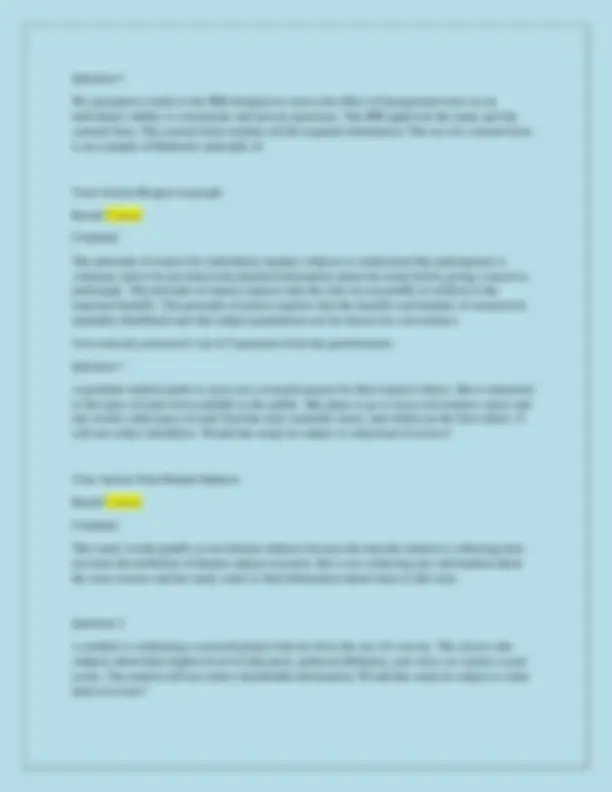
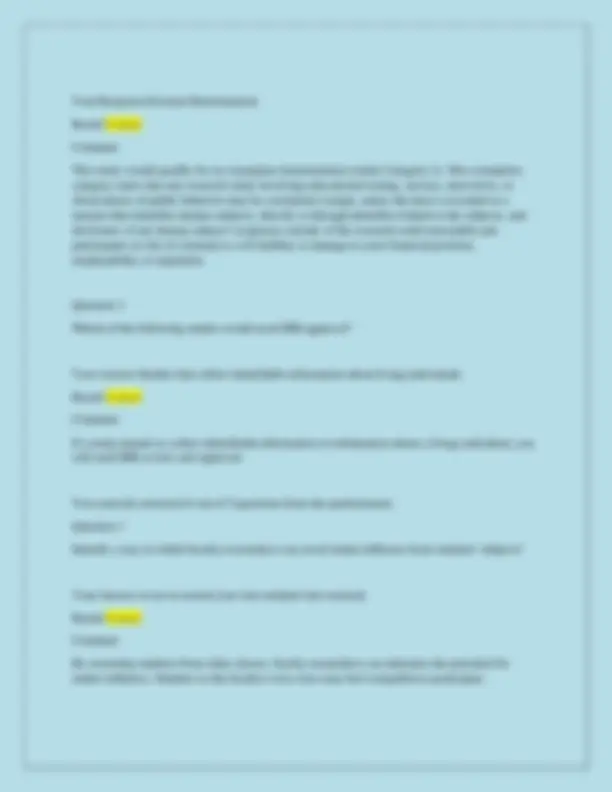
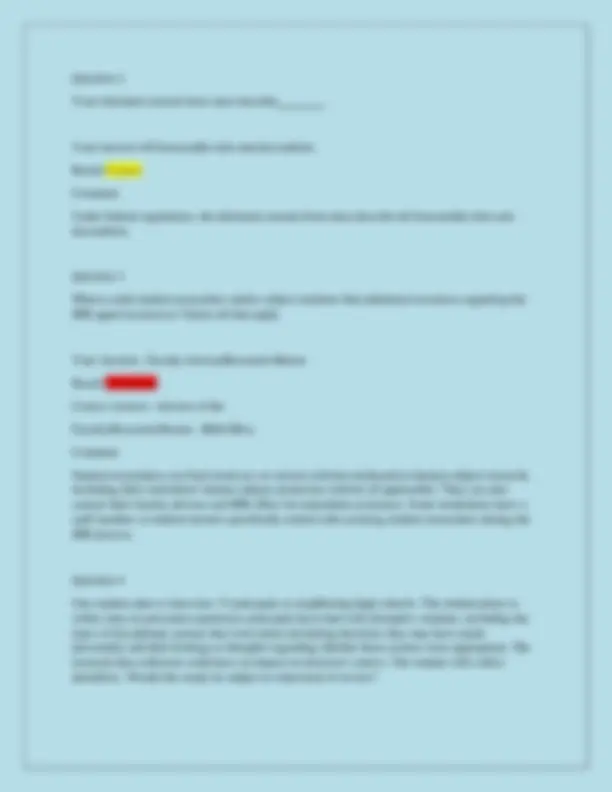
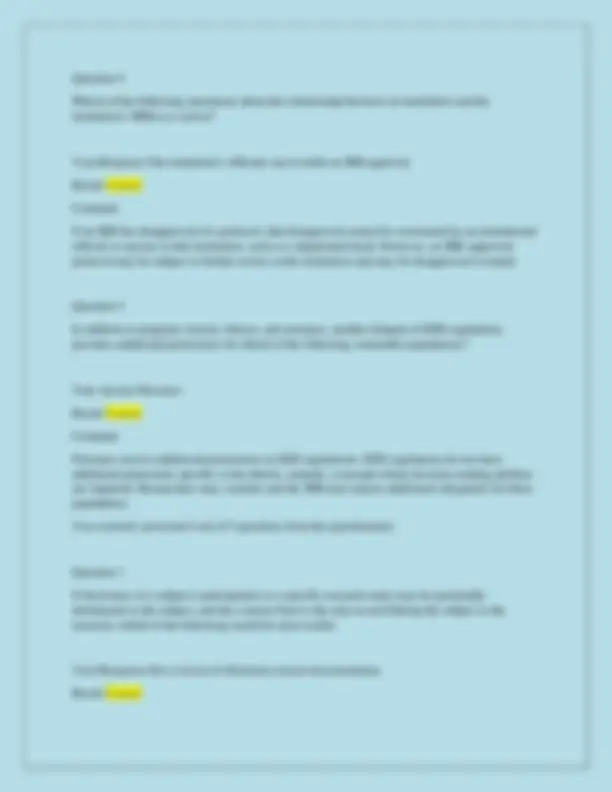
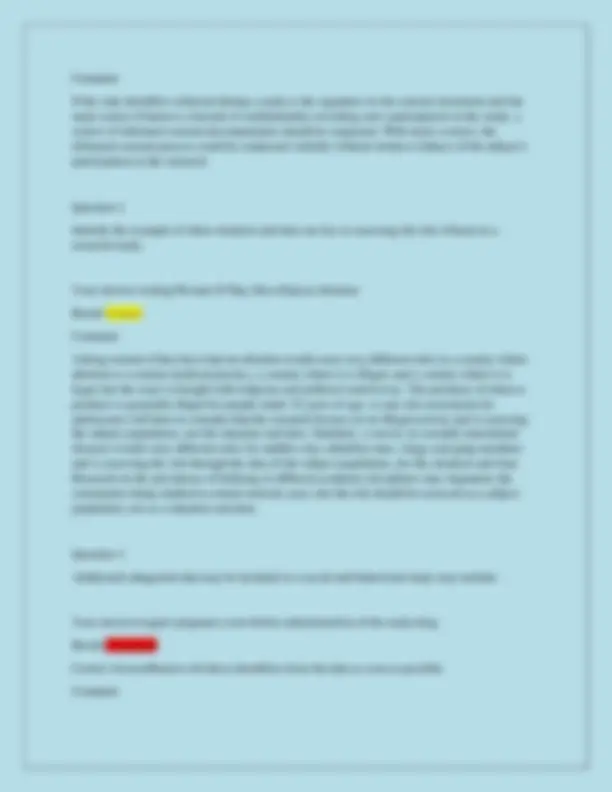
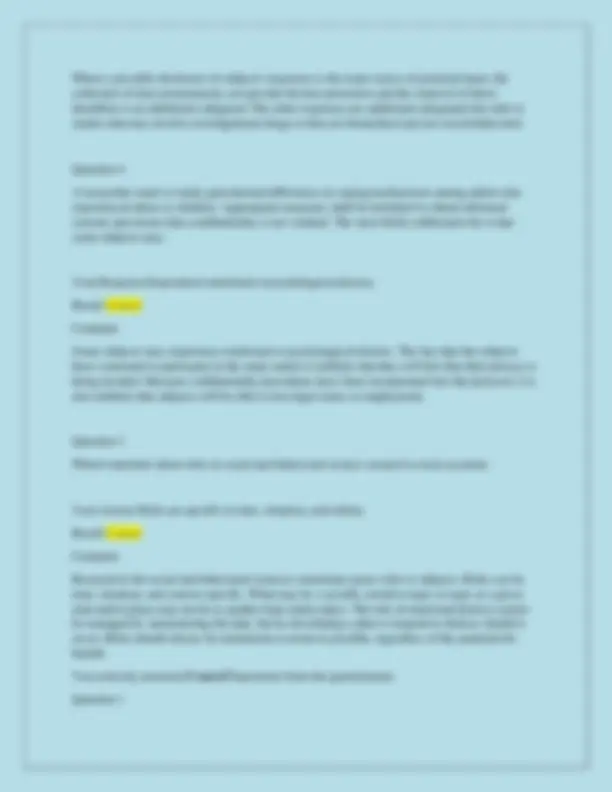
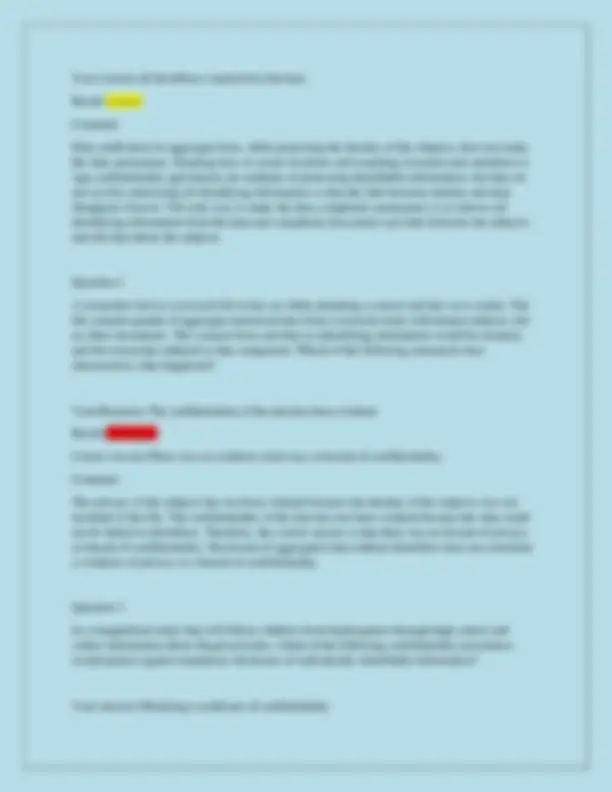
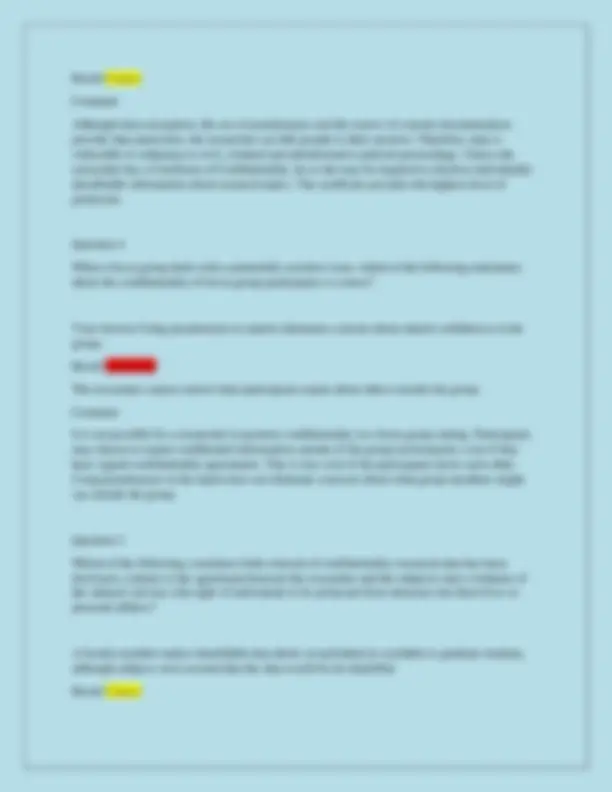
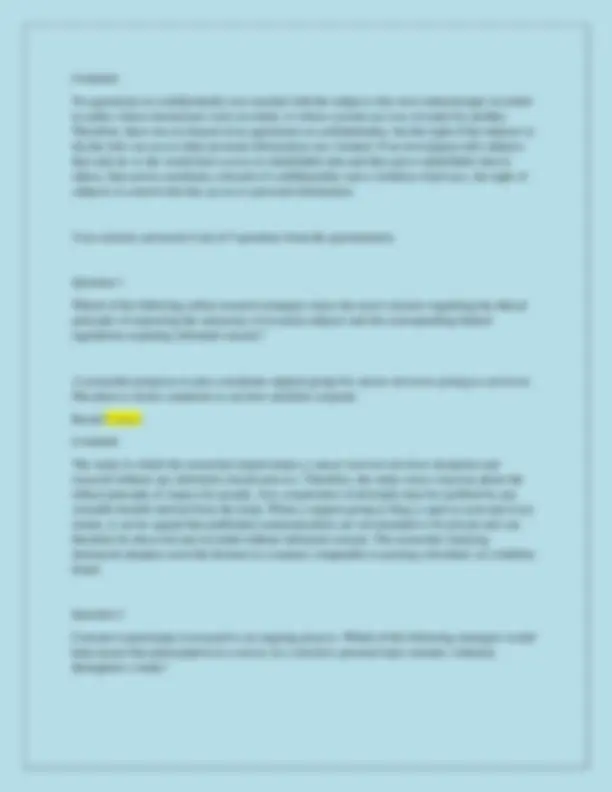
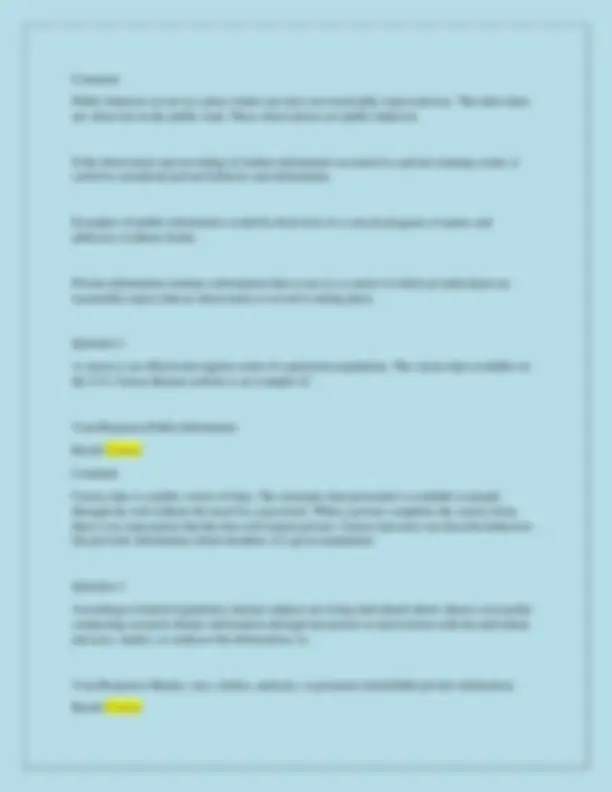
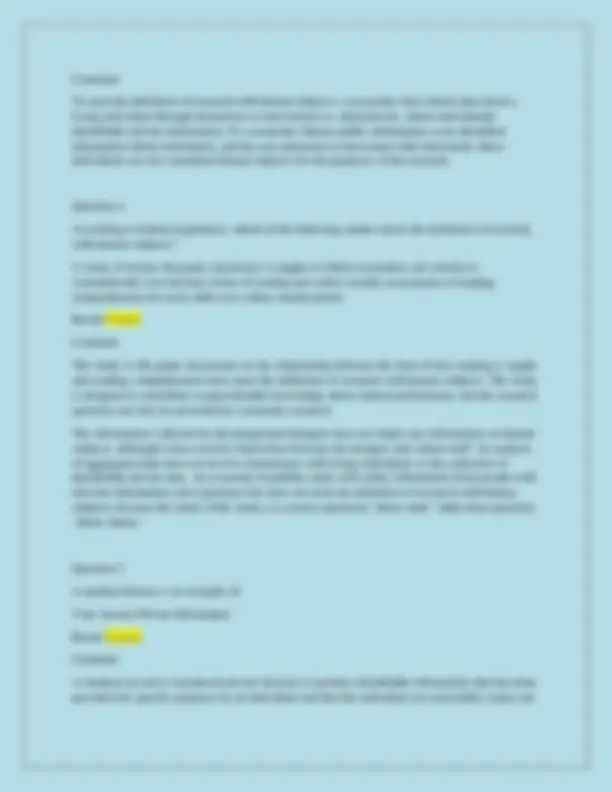



Study with the several resources on Docsity

Earn points by helping other students or get them with a premium plan


Prepare for your exams
Study with the several resources on Docsity

Earn points to download
Earn points by helping other students or get them with a premium plan
Community
Ask the community for help and clear up your study doubts
Discover the best universities in your country according to Docsity users
Free resources
Download our free guides on studying techniques, anxiety management strategies, and thesis advice from Docsity tutors
The Tuskegee study, a research project by the U.S. Public Health Service, involved deceiving and withholding treatment from subjects with syphilis. This led to the creation of the National Commission for the Protection of Human Subjects, which established a U.S. research code of ethics and the Belmont Report, informing federal regulations for protecting human research participants. The document covers key ethical principles, researcher responsibilities, and the unique considerations in online research, highlighting the historical significance and lasting impact of the Tuskegee study on research ethics.
Typology: Exams
1 / 20

This page cannot be seen from the preview
Don't miss anything!













llOOMMooAARRcPSSDD||3 388778833442255
You correctly answered 5 out of 5 questions from the questionnaire. Question 1 The failure of the researcher to protect research subjects from deductive disclosure of identity (i.e., re-identification of subjects by other researchers) is the main ethical violation in which of the following studies? Your Answer Study "Tastes, Ties and Time (T3)" Result Correct Comment Although no students were identified by name in the T3 study, some data were specific enough to allow re-identification of students by an outside researcher. This is an example of the lack of protection of subjects from the deductive disclosure of their identities. The main ethical problems of the other studies include physical damage and unforeseen psychological damage. Question 2 Which of the following studies is most directly related to the establishment of the National Research Act in 1974 and ultimately to the Belmont Report and federal regulations for the protection of human beings? Your Answer HHS Tuskegee Study Result Correct Comment In the United States, the news that researchers deceived and withheld the treatment of subjects suffering from syphilis in the PHS Tuskegee Study led to the creation of the National Commission for the Protection of Human Subjects from Biomedical and Behavioral Research (National Commission or "the Commission"). The Commission took it upon itself to establish a U.S. research code of ethics for U.S. research involving human beings and created the Belmont Report which ultimately informed federal regulations for the protection of human beings. The Tearoom Trade Study and the Stanford Prison Experiment occurred before the codification of federal regulations but are not directly related to the establishment of the National Research Act of 1974.
The T3 study occurred after the codification of federal regulations. Question 3 Humphreys' data collection for the Tearoom Trade studio under the pretext that it was a lookout is an example of a violation of the principle of: Your Answer Respect to people Result Correct Comment Humphreys' data collection for the Tearoom Trade studio while posing as a checkpoint is an example of a violation of the principle of respect for people. Respect for people requires that subjects freely choose to participate in research (voluntariness) and that they are adequately informed about a study (informed consent). The principle of beneficence requires balancing the risk of harm with potential benefits. The principle of justice requires that benefits and burdens be equitably distributed and that subject populations are not chosen for convenience. Question 4 A researcher submits a study to the IRB that proposes to evaluate a new after-school online tutoring program for middle school students in a local school district that examines the effect on students' grades. She proposes to do this evaluation at the school her children attend, because she is familiar with the school district. Students can use their personal smartphone or computer to participate in the program. Could this study be determined to be violating which principle of the Belmont Report? Your Response Justice Result Correct Comment This proposal would violate the principle of fairness that requires that the benefits and burdens of research be equitably distributed and that subject populations not be chosen for convenience. Choosing a single school your children attend could be seen as a population of convenience. Evaluating the program at multiple schools in a school district could avoid this problem. If schools in the district have wide variations in household incomes, this study could eliminate students from less affluent families without access to internet service and electronic tools, by failing to ensure that the benefits and burdens of research are equitably distributed. The principle of charity requires that the risks be reasonable in relation to the expected benefits. The principle of respect for individuals requires subjects to understand that participation is voluntary and to be provided with detailed information about the study before giving consent to participate.
Your Response Existent Determination Result Correct Comment This study would qualify for an exemption determination (under Category 2). This exemption category states that any research study involving educational testing, surveys, interviews, or observations of public behavior may be considered exempt, unless the data is recorded in a manner that identifies human subjects, directly or through identifiers linked to the subjects, and disclosure of any human subject's responses outside of the research could reasonably put participants in risk of criminal or civil liability or damage to your financial position, employability or reputation. Question 3 Which of the following studies would need IRB approval? Your Answer Studies that collect identifiable information about living individuals. Result Correct Comment If a study intends to collect identifiable information or information about a living individual, you will need IRB review and approval. You correctly answered 4 out of 5 questions from the questionnaire. Question 1 Identify a way in which faculty researchers can avoid undue influence from students' subjects? Your Answer Avow to recruit your own students into research Result Correct Comment By recruiting students from other classes, faculty researchers can minimize the potential for undue influence. Students in the faculty's own class may feel compelled to participate.
Question 2 Your informed consent form must describe. Your Answer All foreseeable risks and discomforts. Result Correct Comment Under federal regulations, the informed consent form must describe all foreseeable risks and discomforts. Question 3 Where could student researchers and/or subject students find additional resources regarding the IRB approval process? Select all that apply. Your Answers- Faculty Advisor/Research Mentor Result Correction Correct Answer- Advisor of the Faculty/Research Mentor - IRB Office Comment Student researchers can find resources on various websites dedicated to human subject research, including their institution's human subject protection website (if applicable). They can also contact their faculty advisor and IRB office for immediate assistance. Some institutions have a staff member or student mentor specifically tasked with assisting student researchers during the IRB process. Question 4 One student plan to interview 15 principals at neighboring high schools. The student plans to collect data on personal experiences principals have had with disruptive students, including the types of disciplinary actions that were taken (including decisions they may have made personally) and their feelings or thoughts regarding whether those actions were appropriate. The research data collected could have an impact on directors' careers. The student will collect identifiers. Would this study be subject to what kind of review?
Comment Research is eligible for accelerated review when it poses no more than minimal risk to participants and when all activities fall within the categories identified as eligible. Studies with more than minimal risk do not qualify for accelerated review, even if the subjects are adults, the sponsor is in a hurry, or the study replicates previously approved research. Question 2 Continuous review of an approved and ongoing study that poses more than minimal risk that was initially approved by a convened IRB: Your Response Must occur within 12 months of the date of approval. Result Correct Comment The continuous review of an approved protocol must take place within 12 months of the date of approval, even if no additional risks have been identified. Review by a convened IRB is not always required (e.g., if the study was complete and only in data analysis). Any unforeseen issues should be addressed during the ongoing review process, but the review should include other information, such as the number of topics accumulated, any relevant recent literature, and a copy of the current consent form. Question 3 According to federal regulations, research is eligible for exemption, if: Your Answer Investigation falls into one of the eight categories of research activities described in the regulation. Result Correct Comment Research is only eligible for exemption if all activities associated with the research fall into one of the eight categories of activities outlined in federal regulations. Regulations allow some research with children to be exempt (although institutional policy may not be). The duration of the study and the experience of the investigator are not criteria for determining eligibility for exemption.
Question 4 Which of the following statements about the relationship between an institution and the institution's IRB(s) is correct? Your Response The institution's officials can override an IRB approval. Result Correct Comment If an IRB has disapproved of a protocol, that disapproval cannot be overturned by an institutional official or anyone in that institution, such as a department head. However, an IRB-approved protocol may be subject to further review at the institution and may be disapproved (voided). Question 5 In addition to pregnant women, fetuses, and neonates, another Subpart of HHS regulations provides additional protections for which of the following vulnerable populations? Your Answer Prisoners Result Correct Comment Prisoners receive additional protections in HHS regulations. HHS regulations do not have additional protections specific to the elderly, students, or people whose decision-making abilities are impaired. Researchers may consider and the IRB may require additional safeguards for these populations. You correctly answered 4 out of 5 questions from the questionnaire. Question 1 If disclosure of a subject's participation in a specific research study may be potentially detrimental to the subject, and the consent form is the only record linking the subject to the research, which of the following would be most useful: Your Response Get a waiver of informed consent documentation. Result Correct
Where a possible disclosure of subjects' responses is the main source of potential harm, the collection of data anonymously can provide the best protection and the removal of direct identifiers is an additional safeguard. The other responses are additional safeguards but refer to studies that may involve investigational drugs or that are biomedical and not social behavioral. Question 4 A researcher wants to study generational differences in coping mechanisms among adults who experienced abuse as children. Appropriate measures shall be instituted to obtain informed consent and ensure that confidentiality is not violated. The most likely additional risk is that some subjects may: Your Response Experiment emotional or psychological distress. Result Correct Comment Some subjects may experience emotional or psychological distress. The fact that the subjects have consented to participate in the study makes it unlikely that they will feel that their privacy is being invaded. Because confidentiality procedures have been incorporated into the protocol, it is also unlikely that subjects will be able to lose legal status or employment. Question 5 Which statement about risks in social and behavioral science research is more accurate: Your Answer Risks are specific to time, situation, and culture. Result Correct Comment Research in the social and behavioral sciences sometimes poses risks to subjects. Risks can be time, situation, and context specific. What may be a socially sensitive topic or topic at a given time and/or place may not be at another time and/or place. The risk of emotional distress cannot be managed by anonymizing the data, but by developing a plan to respond to distress should it occur. Risks should always be minimized as much as possible, regardless of the potential for benefit. You correctly answered 5 out of 5 questions from the questionnaire. Question 1
AskA therapist at a free college clinic treats elementary school children with behavior problems who are referred by a social service agency. She is also a doctoral candidate who proposes the use of the data she has and will collect about children for a case-based research project. Which of the following statements about parental permission is correct? Parents of children may feel pressure to give the therapist permission to use their children's data so that she continues to provide services to their children. Result Correct CommentWhen a caregiver becomes a researcher, both child clients and their parents may not feel free to choose not to participate in the provider's study. An investigator who is also a care provider should be very clear that the decision not to participate in a study, or to allow records to be used, will not affect the care provided in the future. The fact that the therapist has access to his clients' records as a physician does not entitle him to use the information in the records for research purposes without parental permission and the child's consent. Permission from a school authority to conduct research does not replace the need for permission or consent. Finally, the right of children to choose cannot be overridden in the pursuit of an indeterminate Community interest. Question 2 QuestionA general requirement for informed consent is that no informed consent can include any exculpatory language. Exculpatory language is one that waives or appears to waive any of the subject's legal rights or releases or appears to release those conducting the investigation from negligence liability. Which of the following statements in the form of consent is an example of exculpatory language? Your Response Participating in the investigation is voluntary, but if you choose to participate, you waive the right to legal redress for any injury related to the investigation. Result Correct CommentA statement on a consent form that subjects who agree to participate in research waive their legal rights constitutes exculpatory language. Statements about the voluntary nature of consent, about the possible need to remove subjects from a study to protect their well-being, and statements about the provision of references do not waive the rights of subjects. Question 3 QuestionOne criterion for waiving informed consent is that, where appropriate, subjects receive additional pertinent information after the study. In which of the following studies it would NOT be appropriate to provide subjects with information about missing elements of consent: A study in which subjects were assigned to study activities based on an undesirable or unflattering physical characteristic evaluated by members of the research team. Result Correct
Your Answer all identifiers connected to the data. Result Correct Comment Data notification in aggregate form, while protecting the identity of the subjects, does not make the data anonymous. Keeping keys in secure locations and requiring research team members to sign confidentiality agreements are methods of protecting identifiable information, but they do not involve destroying all identifying information so that the link between identity and data disappears forever. The only way to make the data completely anonymous is to remove all identifying information from the data and completely disconnect any links between the subjects and the data about the subjects. Question 2 A researcher leaves a research file in her car while attending a concert and her car is stolen. The file contains graphs of aggregate numerical data from a research study with human subjects, but no other documents. The consent form said that no identifying information would be retained, and the researcher adhered to that component. Which of the following statements best characterizes what happened? Your Response The confidentiality of the data has been violated. Result Correction Correct AnswerThere was no violation of privacy or breach of confidentiality. Comment The privacy of the subjects has not been violated because the identity of the subjects was not included in the file. The confidentiality of the data has not been violated because the data could not be linked to identifiers. Therefore, the correct answer is that there was no breach of privacy or breach of confidentiality. Disclosure of aggregated data without identifiers does not constitute a violation of privacy or a breach of confidentiality. Question 3 In a longitudinal study that will follow children from kindergarten through high school and collect information about illegal activities, which of the following confidentiality procedures would protect against mandatory disclosure of individually identifiable information? Your Answer Obtaining a certificate of confidentiality
Result Correct Comment Although data encryption, the use of pseudonyms and the waiver of consent documentation provide data protection, the researcher can link people to their answers. Therefore, data is vulnerable to subpoena in civil, criminal and administrative judicial proceedings. Unless the researcher has a Certificate of Confidentiality, he or she may be required to disclose individually identifiable information about research topics. The certificate provides the highest level of protection. Question 4 When a focus group deals with a potentially sensitive issue, which of the following statements about the confidentiality of focus group participants is correct? Your Answer Using pseudonyms in reports eliminates concern about shared confidences in the group. Result Correction The researcher cannot control what participants repeat about others outside the group. Comment It is not possible for a researcher to promise confidentiality in a focus group setting. Participants may choose to repeat confidential information outside of the group environment, even if they have signed confidentiality agreements. This is true even if the participants know each other. Using pseudonyms in the report does not eliminate concerns about what group members might say outside the group. Question 5 Which of the following constitutes both a breach of confidentiality (research data has been disclosed, contrary to the agreement between the researcher and the subjects) and a violation of the subjects' privacy (the right of individuals to be protected from intrusion into their lives or personal affairs)? A faculty member makes identifiable data about sexual behavior available to graduate students, although subjects were assured that the data would be de-identified. Result Correct
Your Answer Dar examples in the consent process of the types of questions to be asked. Result Correction Correct AnswerDesign the survey so that subjects are not forced to answer one question before moving on to the next. Comment Voluntary participation in research includes the right to withdraw from a study at any time and the right to opt out of answering questions. Online surveys that force subjects to answer one question before moving on to the next one violate the requirement that all participation in research be voluntary. Providing contact information for the researcher, privacy policies, and survey description are important, but do not address the requirement. Question 3 To minimize the potential risks of harm, a researcher conducting an online survey can: Your Answer Did the survey so that no direct or indirect identifiers are collected. Result Correct Comment In most Internet-based research, the main risk of harm is a breach of confidentiality. A simple way to help maintain the confidentiality of a subject's identity is not to collect direct or indirect identifiers. Suggesting that subjects should print a copy of the informed consent form does not protect them from an inadvertent violation of identifiable responses. Similarly, compliance with the Terms of Service does not protect against a breach. It must be specified that all subjects are of legal age does not guarantee compliance. Question 4 Researchers striving to conduct an online study should consider that there are some potential risks of harm to subjects unique to Internet-based research. One of these risks is: Individuals may post privately identifiable information about themselves online without the intention of making it public and available to researchers. Result Correct Comment Information posted online could possibly be accessible to anyone with an Internet connection. However, individuals may post their privately identifiable information online without the intent
of making this information public. Privately identifiable information that can be accessible to anyone can create the potential for several different risks of harm to subjects who may not be aware that their information is public. Assuming a pseudonymous online identity poses no risk of harm to subjects. While it is true that researchers can recruit, consent and inform subjects online with little or no interaction, this, would also not pose any risk of harm to subjects. Similarly, waiving consent documentation does not pose any potential risk of harm to subjects and is not unique to Internet-based research. Question 5 Which of the following methods could be considered a "best practice" in terms of informing respondents how their responses to an online survey about personal information will be protected? The researcher uses the informed consent process to explain how respondents' data will be transmitted from the website to its encrypted database without ever recording respondents' IP addresses but explains that confidentiality cannot be absolutely guaranteed on the Internet. Result Correct Comment Although there are no guaranteed methods to ensure absolute confidentiality of research data collected online, some Internet-based research experts have identified "best practices" to describe commonly accepted confidentiality protections, such as including explanations about how data is transmitted from the subject to the researcher, how the researcher will maintain and secure the data. Consent processes should also include a discussion to emphasize that there is no way to guarantee absolute confidentiality if the data is personal or sensitive in nature. You correctly answered 5 out of 5 questions from the questionnaire. Question 1 A researcher is interested in evaluating risk-taking by individuals. The investigator is sitting on a bench near a busy four-way intersection. She plans to record the number of cyclists wearing a safety helmet and whether they stop at the intersection before proceeding to correlate wearing safety clothing with risk-taking. This collection of information is an example of: Your Response Public behavior Result Correct
Comment To meet the definition of research with human subjects, a researcher must obtain data about a living individual through interaction or intervention or, alternatively, obtain individually identifiable private information. If a researcher obtains public information or de-identified information about individuals, and has not interacted or intervened with individuals, those individuals are not considered human subjects for the purposes of the research. Question 4 According to federal regulations, which of the following studies meets the definition of research with human subjects? A study of twenty 4th grade classrooms is taught in which researchers ask schools to systematically vary the time of day of reading and collect weekly assessments of reading comprehension for each child over a three-month period. Result Correct Comment The study in 4th grade classrooms on the relationship between the time-of-day reading is taught and reading comprehension does meet the definition of research with human subjects. The study is designed to contribute to generalizable knowledge about student performance and the research question can only be answered by systematic research. The information collected by the playground designer does not imply any information on human subjects, although it does involve interaction between the designer and school staff. An analysis of aggregated data does not involve interactions with living individuals or the collection of identifiable private data. An economic feasibility study will collect information from people with relevant information and experience but does not meet the definition of research with human subjects, because the intent of the study is to answer questions "about what" rather than questions "about whom." Question 5 A medical history is an example of: Your Answer Private Information Result Correct Comment A medical record is considered private because it includes identifiable information that has been provided for specific purposes by an individual and that the individual can reasonably expect not
to be made public. A medical record is not considered public information, nor is it considered a behavior. Private information includes information that occurs in a context in which an individual can reasonably expect that no observation or record is being conducted, and information that has been provided for specific purposes by an individual and that the individual can reasonably expect will not be made public (e.g., a medical record).